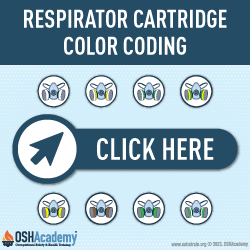Cartridges, Canisters, and Filters
Cartridges usually attach directly to the respirator facepiece.
The larger-volume canisters attach to the chin of the facepiece or are carried with a harness and attached to the facepiece by a breathing tube. Combination canisters and cartridges contain layers of different sorbent materials and remove multiple chemicals or multiple classes of chemicals from the ambient air.
Filters may also be combined with cartridges to provide additional protection against particulates.
Several standard cartridges and canisters are commercially available. They are color-coded to indicate the general chemicals or classes of chemicals against which they are effective (See the image to the right).
Respirators should be used only for those substances for which they have been approved. Use of a sorbent is not allowed when there is reason to suspect it does not provide adequate sorption efficiency against a specific contaminant. Approval testing is performed at a given temperature and over a narrow range of flow rates and relative humidity; thus, protection may be compromised in nonstandard conditions.
Most chemical sorbent canisters are imprinted with an expiration date. They may be used up to the expiration date if they were not opened previously. Once opened, they begin to absorb humidity and air contaminants whether in use or not. Their efficiency and service life decreases, and therefore they should be used immediately. Cartridges should be discarded after use but should not be used for longer than one shift or when breakthrough occurs, whichever comes first.
Fit Testing
A respirator can't protect you if it doesn't fit your face. It's that simple. Certain respirators, known as tight-fitting respirators, must form a tight seal with your face or neck to work properly. If your respirator doesn't fit your face properly, contaminated air can leak into your respirator facepiece, and you could breathe in hazardous substances.
Before you wear a tight-fitting respirator at work, your employer must be sure that your respirator fits you. Your employer does this by performing a fit test on you while you wear the same make, model, and size of respirator that you will be using on the job. That way, you know that your respirator fits you properly and can protect you, as long as you use it correctly.
OSHA standard 1910.134 Appendix A details fit testing requirements and procedures.
Warning Properties of Substances
Respiratory Protection in General Industry
Warning properties are essential to safe use of air-purifying respirators since they allow detection of contaminant breakthrough, should it occur. While warning properties are not foolproof, because they rely on human senses which vary widely among individuals and in the same individual under varying conditions (e.g., olfactory fatigue), they do provide some indication of possible sorbent exhaustion, poor facepiece fit, or other malfunctions.
Where a canister or cartridge is being used against gases or vapors, the appropriate device must be used only if the chemical(s) have "adequate warning properties."
- NIOSH considers a substance to have adequate warning properties when its odor, taste, or irritant effects are detectable and persistent at concentrations below the recommended exposure limit (REL).
- A substance is considered to have poor warning properties when its odor or irritation threshold is above the applicable exposure limit.
OSHA permits the use of air-purifying respirators for protection against specific chemicals with poor warning properties if:
- the service life of the sorbent is known and a safety factor has been applied, or
- the respirator has an approved end-of-service- life indicator.
If you have time, take a look at the video to the right on Respiratory Protection.
Knowledge Check Choose the best answer for the question.
1-12. When does NIOSH consider a substance to have adequate warning properties?
You forgot to answer the question!

